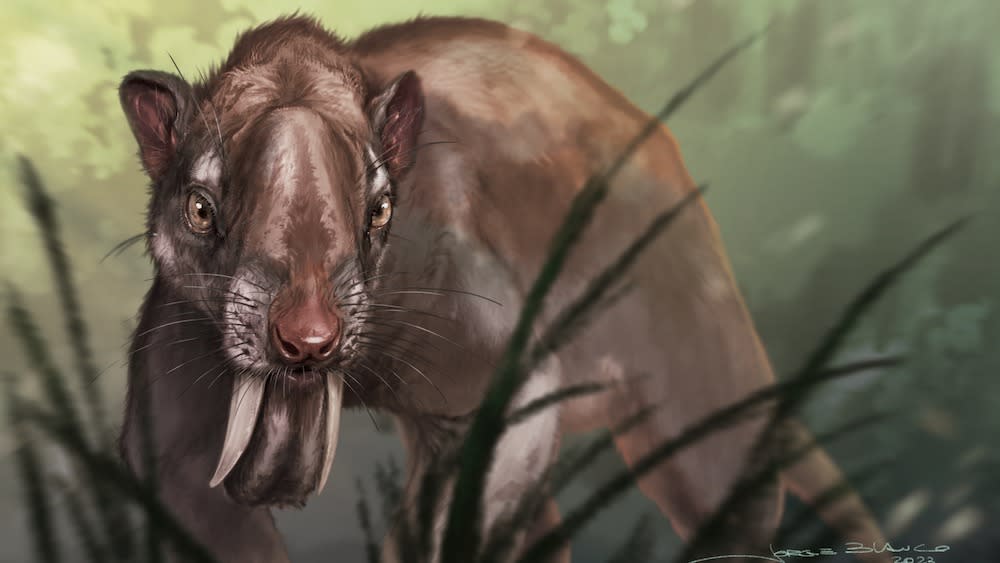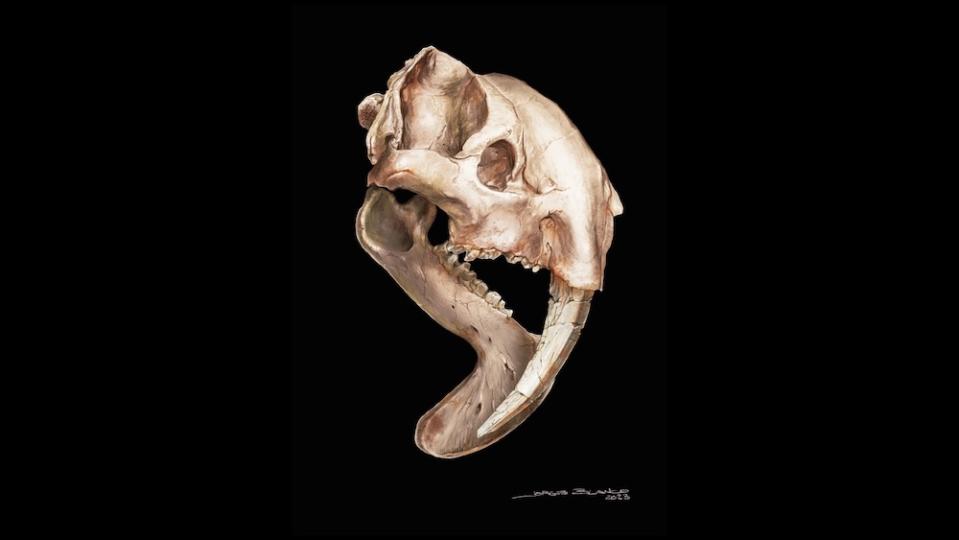Ancient marsupial sabertooth had eyes like no other mammal predator


Despite having eyes as wide-set as a cow's and surprisingly long upper-canine teeth with roots tunneling deep into its skull, the "marsupial sabertooth" proved to be an effective carnivore, a new study finds.
This ferocious marsupial is an extinct mammal from South America scientifically known as Thylacosmilus atrox. Scientists from Argentina and the United States examined computed tomography (CT) scans of the skulls of three of the large predators, which would have weighed roughly 220 pounds (100 kilograms) and went extinct about 3 million years ago. The team noticed that the animal's odd cranial anatomy stood out compared with other carnivores, such as dogs and cats, whose eyes are more forward-facing to help them track prey, according to the study published Tuesday (March 21) in the journal Communications Biology.
"What we expect for any carnivore is that [their eye sockets] usually have very convergent orbits, meaning their vision is oriented toward the front," giving them good depth perception, said study lead author Charlène Gaillard, a postgraduate student at the Argentine Institute of Nivology, Glaciology, and Environmental Sciences (IANIGLA) in Mendoza, Argentina. "When you're a predator, you want to be able to locate your prey as accurately as possible," Gaillard told Live Science.
This accuracy occurs when the left and right fields of vision overlap and send information to the brain, enabling "the brain to interpret depth and distances," resulting in 3D vision, Gaillard said.
Related: Ancient saber-toothed 'gorgons' bit each other in ritualized combat
But the marsupial sabertooth’s eye placement is more in line with herbivores such as cows and horses, which see the world in 2D, leading scientists to wonder if this hypercarnivore, whose diet consisted of at least 70% meat, could see in 3D at all.
After examining the scans, the researchers discovered that the beast was able to compensate for its odd eye placement by sticking its orbits outward and orienting them vertically, which helped it achieve a 70-degree visual field overlap — similar to that of a cat, according to the study.

"This was enough to help make it a successful predator," Gaillard said.
So, what caused T. atrox to evolve to have such wonky eye positioning in the first place? The researchers said that's all thanks to its staggeringly long canine teeth, which were "ever-growing" throughout its lifetime, with the roots pushing further back into its skull over time. This "displacement" resulted in the animal's unique wide-set eyes, since its canine teeth were "invasive to the dorsal [front] part of the skull," Gaillard said.
RELATED STORIES
—Ancient 'shapeshifting vampire demon' anchovy had saber tooth and fangs
—Why are there so many marsupials in Australia?
—Not just tiny arms: T. rex also had super small eyes to accommodate a big bite
However, the researchers are unclear of whether or not its enormous chompers offered any benefits while hunting, since there are currently no other mammals that evolved to have a similar characteristic, including kangaroos and other marsupials that are distant cousins of T. atrox.
"It was likely advantageous to have these huge canine teeth," Gaillard said, "and it was even more advantageous to have them with regards to having better vision."

